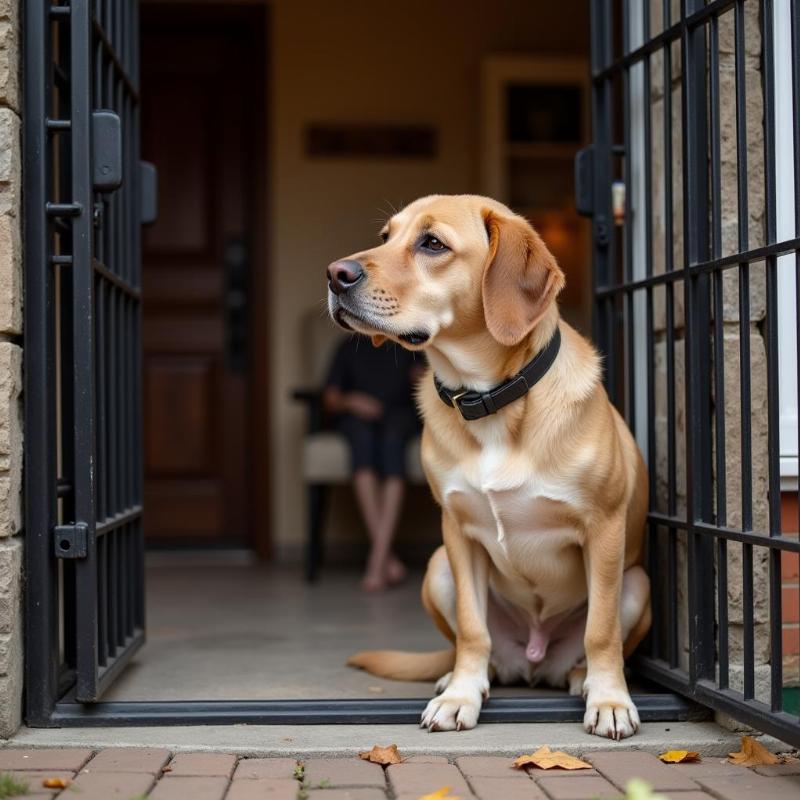If your furry friend suddenly refuses to sleep in their once-loved crate, you’re not alone. Many dog owners experience this frustrating change in behavior. Understanding why your dog won’t sleep in their crate anymore is the first step to resolving the issue and restoring peaceful nights for both of you. This article will explore the common reasons behind this behavior change and provide effective solutions to help your dog feel comfortable and secure in their crate again.
Why Has My Dog Suddenly Decided the Crate Is a No-Go Zone?
Several factors can contribute to a dog’s sudden aversion to their crate. Identifying the root cause is crucial for implementing the right solution. Has something changed in your dog’s routine, environment, or health? Consider these possibilities:
- Medical Issues: Underlying health problems, such as arthritis, urinary tract infections, or even cognitive decline, can make the crate uncomfortable or even painful. If your dog exhibits other unusual behaviors like whining, pacing, or loss of appetite, consult your veterinarian immediately.
- Negative Associations: A frightening event, like a thunderstorm or fireworks display while crated, can create a negative association with the crate. Even a less dramatic experience, like being accidentally shut in for too long, can make your dog anxious about the crate.
- Age and Life Stage: Puppies often outgrow their initial crate training as they mature. Similarly, senior dogs may develop new anxieties or physical limitations that make crate confinement challenging.
- Changes in Routine: Disruptions to your dog’s daily routine, like a new family member, a move, or a change in your work schedule, can create stress and anxiety, leading to crate avoidance.
- Boredom or Lack of Exercise: If your dog isn’t getting enough physical activity and mental stimulation, they may become restless and frustrated in their crate. A tired dog is a happy dog, and a happy dog is more likely to settle down for a good night’s sleep.
 Dog refusing to enter crate
Dog refusing to enter crate
Retraining Your Dog to Love Their Crate
Once you’ve pinpointed the potential cause, you can begin retraining your dog to see their crate as a safe and comfortable space. Remember, patience and positive reinforcement are key.
- Veterinary Check-up: Rule out any underlying medical issues first. A clean bill of health ensures you’re addressing behavioral issues, not masking a medical problem.
- Positive Associations: Make the crate a positive place by associating it with good things. Offer treats, toys, and praise when your dog enters the crate voluntarily. Feed your dog their meals in the crate to create a positive connection.
- Gradual Introduction: Don’t force your dog into the crate. Start by leaving the door open and encouraging them to explore it on their own terms. Gradually increase the time they spend in the crate, rewarding them for calm behavior.
- Create a Comfortable Environment: Ensure the crate is a cozy and inviting space. Provide a soft bed, familiar blankets, and a favorite toy. Consider covering the crate with a blanket to create a den-like atmosphere.
- Exercise and Enrichment: A tired dog is more likely to sleep soundly. Ensure your dog gets plenty of physical exercise and mental stimulation throughout the day. A long walk, a game of fetch, or a puzzle toy can work wonders.
Addressing Specific Challenges
- Separation Anxiety: If your dog’s crate aversion stems from separation anxiety, consult a certified professional dog trainer or veterinary behaviorist. They can provide tailored strategies to help your dog cope with being alone.
- Fear of the Crate: If your dog is genuinely afraid of the crate, desensitization and counter-conditioning are essential. Slowly reintroduce the crate, pairing it with positive experiences, and gradually increasing the time spent inside.
Conclusion
Addressing your dog’s refusal to sleep in their crate requires patience, understanding, and a tailored approach. By identifying the underlying cause and implementing the appropriate retraining techniques, you can help your dog rediscover the comfort and security of their crate and restore peaceful nights for everyone. Remember, consistency is key to success.
FAQ
- My dog used to love his crate, why the sudden change? Several factors can contribute, such as medical issues, negative associations, age, or changes in routine.
- Should I force my dog into the crate? Never force your dog into the crate. This can worsen their anxiety and create further negative associations.
- How long will it take to retrain my dog? The retraining process varies depending on the underlying cause and your dog’s individual temperament. Be patient and consistent.
- What if my dog continues to refuse the crate? If you’re struggling, consult a certified professional dog trainer or veterinary behaviorist for personalized guidance.
- Can I use medication to help my dog sleep in the crate? Medication should only be used as a last resort and under the guidance of a veterinarian.
- Is it cruel to crate train a dog? When done correctly, crate training provides dogs with a safe and secure den-like space. It is not inherently cruel.
- What if my dog is too old to be crate trained? Older dogs can still be crate trained, but the process may require more patience and adjustments to accommodate their age and physical limitations.
Beautdogs.us is your premier destination for all things dog-related in the US. We offer expert advice on dog breeds, care, training, and product recommendations. Whether you’re a seasoned dog owner or just starting your journey, Beautdogs.us is your trusted resource for comprehensive and engaging canine information. Contact us for personalized support at [email protected] or call us at +1 501-555-7529. Visit Beautdogs.us today!